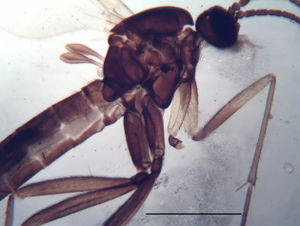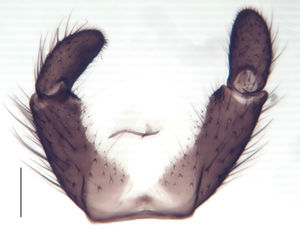Trichosiopsis doczkali
Ordo: Diptera
Familia: Sciaridae
Genus: Trichosiopsis
Name
Trichosiopsis doczkali unpublished
Type material
Holotype: ♂, 23.5.–6.6.2014, Malaise trap, leg. Doczkal et al., BC-ZSM-DIP-22490-A05 in ZMSC
Type locality
Germany, Bavaria, Oberstdorf, Laufbachstiege, 47.3923 N 10.3706, 1908 m
Description (male)
Head. Eye bridge 5 rows of facets. Antenna unicolour. LW-index of 4th flagellomere 2.05–2.3; neck 0.28–0.38 × segment width; transition of basal part to neck pronounced. Colour of neck unicolour. Antennal setae shorter than segment width; of normal strength; dense; salient. Palpus darkened; long; palpomeres 3. First palpomere elongate; with 5–6 setae; with only sparse sensilla. Second palpomere elongate. Third palpomere as long as first. Thorax. Colour brown. Notum unicolour. Thoracic setae long and strong. Posterior pronotum setose. Postpronotal setae 3–6; fine. Mesothoracic sclerites bare. Legs. Colour patterned. Hind coxa of same colour as femora, or darkened. Setae on front coxa pale. Front tibial organ as patch of setae; dark, or pale; front tibial organ not bordered. Tibial setae on hind legs normal, shorter than tibial width, or very strong, as long or longer longer than tibial width. Tibial spurs of equal length. Claws untoothed. Wing. Wing hyaline; of normal shape. Wing membrane without macrotrichia. Wing venation weak, with faint stM. M-fork of normal shape. R1 ending at or slightly before base of m-fork; posterior veins with macrotrichia; stM mostly with macrotrichia; CuA1 and CuA2 mostly with macrotrichia; bM setose; r-m mostly setose; bM:r-M 0.85–10.5; st-Cu:bM 0.25–0.45; R1:R 1.15–1.35; c:w 0.52–0.62. Halter darkened; of normal length. Abdomen. Abdominal setae strong; dense; on tergites dark and pale; on sternites white. Hypopygium concolour with abdomen; LW-index 0.6–0.8. Base of gonocoxites with weak setae; gonocoxites broadly separated; inner margin of gonocoxites typically U-shaped; inner membrane of hypopygium scarcely setose; ventral margin of gonocoxite with short setae. Gonostylus elongate; LW-index 2.4–2.7; Inner margin straight, or concave; apex equally rounded. Apical tooth present; without internal structure; of medium strength; LW-Index 2–3. Awl-like setae normal; present beneath apical tooth. Megasetae absent. Whiplash-hair absent. Tegmen without special features; central process absent. Length of ejaculatory apodeme/hypopygium 25–33 %; base of ejaculatory apodeme present. Field with aedeagal teeth inconspicuous. Measurements. Body size 4–5 mm. Hind tibia 1.7–1.82 mm. Wing length 3.4–4.2 mm.
Diagnosis
Trichosiopsis doczkali is a typical species of the Trichosiopsis trochanterata complex, characterized by an elongate, tapered gonostylus and partly bright body hairs. It is most similar to Trichosiopsis saltuum by the long setae at the hind tibia and mostly dark legs. However, the fore legs in Tr. doczkali are completely yellow and the posterior legs dark with the apical part of the coxae and the tibiae yellow. The species is also notable by its size. With a body length of more than 4 mm it is the largest species, which is currently known in the trochanterata complex.
DNA Barcoding
The COI sequence is assigned to BIN BOLD:ACX2768 (n=1, K2P: 10.53%).
Etymology
The species is named after its collector, Dieter Doczkal, Munich, who has sorted out the alpine material and had an eye to pick out this specimen from the bulk of diptera in alpine samples.
Discussion
This large, but not very distinctive species demonstrates once again the immense and probably still largely unknown diversity of alpine Trichosiopsis.
Distribution
Germany.
Images
|




